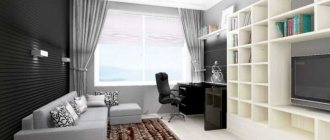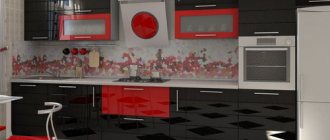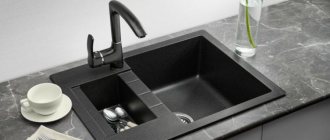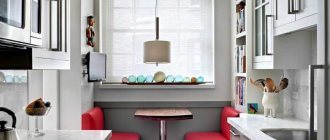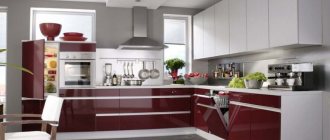Kitchen layout options
Rails can be placed in three ways:
- Horizontal. A classic look for a functional home railing system, where the pipe is attached between the countertop and the upper kitchen cabinets. Hooks, baskets, shelves and other accessories are hung on it. To easily make the most of your space, arrange your kitchen rails in several rows on an empty wall.
- Vertical. The pipe is installed vertically from the tabletop to the ceiling, and shelves and baskets are attached to it at a distance from each other. Most often used for bar counters and peninsulas. But such a design will fit no less perfectly into the free corner of an English kitchen set.
- Suspension. Based on the name, you guess that the railing system hangs from fasteners, from the ceiling. It looks most impressive above the island - suitable for organizing the storage of pans and cutting boards. Or above the bar counter - for glasses, shot glasses and even bottles.
Installing roof rails in the kitchen
The basis of such a product is a hollow tube, a stainless steel rod with a diameter of several centimeters
If you decide to install a roof rail in the kitchen, several problems will be solved at once:
- Saving free space;
- Placing frequently used items in the right place;
- Beautiful appearance.
“Such crossbars with accessories are needed not only to save working area, but also time. Therefore, place it in the work area.”
Installation process of roof railing systems
- Drill a hole in a certain place using a drill or hammer drill;
- Install the mount according to the instructions;
- Attach accessories for railing (shelves, holders, hooks);
- Install the crossbar itself;
- Place a plug.
“Horizontal types of roof rails for the kitchen are mounted at a height of 8-10 cm from the bottom of the wall facade. The mount must be reliable and capable of supporting all the utensils that you decide to place there.”
| What should you consider when installing roof rails? |
| All kitchen utensils located should be at arm's length |
| If you choose a vertical type, you must be confident in the reliability of the ceiling and the parallel surface |
| Arrange and hang utensils according to frequency of need |
| Do not place spatulas, spoons and knives above the gas stove! |
| Don't forget to place the cookbook on one of the installed shelves. |
What types of roof rails and hanging accessories are there?
The railing system includes the following basic elements:
- The roof rails themselves are most often in the form of a pipe with a diameter of 16 mm at the end or in the form of a flat strip. The length of one rod/bar can be 40, 60 (see photo below), 80, 100, 120 cm or 3 m.
- Wall holders - most often they are sold complete with a rod and screws, their number depends on the length of the railing. The holders can be standard or end-mounted (for fastening the crossbar between two walls).
- Caps - installed at the ends of the rails to make them look nice and be closed on both sides.
- Corner adapters (if necessary) - are used to combine two adjacent rails, while couplings are inserted into them at the junction points, then the joints are closed with holders. Of course, it is not at all necessary to connect adjacent rods; they can simply be closed with plugs.
- Coupling (if necessary) - is inserted into the holes of two pipes, then they are connected under pressure. A holder is always placed at the joint.
In addition to the basic elements, hanging accessories are a must - they must be selected based on individual needs.
- S-shaped hooks - they can be large or small, as well as double. You can hang on them not only ladles, colanders and potholders, but also any utensils, dishes, cutting boards, graters.
- Mini-shelves - you can put anything on them, for example, cans of bulk products, sauces, oil, etc. Shelves are small and large, regular and corner, single- or double-tiered, with or without additional holders.
- Baskets and glasses - designed for storing utensils, whisks, spatulas, and even for growing plants, such as herbs.
- Drainer .
- Drying rack for appliances.
- A towel holder - for example, may have a crossbar and several hooks.
- Paper towel holder.
- Holder for lids from pots and pans.
- Knife holder.
- Board holder.
- Holder for tablet or cookbook.
- Hot stand.
- A shelf for spices – as a rule, it is narrow and can be two-level. You can often purchase “original” spice jars for your shelf.
- Shelf for wine glasses.
- Bottle shelf.
- Holder for mugs and glasses.
- Breadbox.
- Holder for rolls: towels, foil, film, baking paper.
All these elements can be combined in one design, for example, a bottle holder with a glass holder or, say, a board holder with a knife organizer.
Install additional organizers
See all about new roof rails, hanging systems and other kitchen accessories here:
Hooks
Can be attached to any surface without grease. It is allowed to install them to any facing coating. Household goods, towels, aprons, bags or potholders are attached to them . There are hooks with Velcro. They are ideal for quick installation. No additional elements in the form of a hammer, nails or screws are required. It is enough to wash the surface, if it becomes dirty, wipe it dry and attach this element.
Special shelves
Corner and straight shelves are sold. They are made from wood, glass or metal. Depending on what will be stored on them, their thickness is selected. It is possible to purchase an option with decor. These elements can even become a work of art, but then it is also worth storing things of light weight on them. Typically, simple, level shelves are used to fill cabinets, on which all the utensils that could be stored in cabinets are installed.
Magnets holders for knives in the interior
Special devices make it easy to install knives. There is no need to place them in a closet, where they are difficult to find, or to install them in a special container. Attaching a knife to a magnet reduces the risk of injury, since it is stored separately in a designated place and cannot cause injury when searching for another item. Always nearby. If necessary, it can be quickly detached from the mount and used for its intended purpose.
Other railing options
Modern kitchen accessories are not only hooks, but also magnets, bags for small vegetables, etc.
- containers for small items;
- baskets for food or bottles, small boxes;
- hangers for dishes, cups;
- book holders;
- cups;
- soap dishes.
What can you hang on the railing?
A pipe on the wall alone will not add functionality to your loft kitchen. The most important thing is the hanging modules, which are selected and placed depending on everyone’s personal preferences.
Let's look at the main pendant options:
- Hook . The simplest and most cost-effective, yet effective filling. You can hang various ladles, spatulas, towels, potholders, frying pans, stewpans and much more on them.
- Shelf . Depending on the size and depth, they store everything from detergents and sponges to jars of sauces and seasonings.
- Basket . The high edges make it safer than a shelf and better suited for tall bottles and cans.
- Cup . Not all kitchen utensils have holes and hooks, having a glass will solve this problem - just put cutlery, spatulas and other things in it.
Dryer. They are used both for temporary arrangement of dishes after washing, and for permanent storage of the main set of plates and mugs.
Holder. Special designs are developed for:
- paper towels;
- foil, baking paper and film;
- pots and pans;
- covers;
- cookbooks and tablets;
- cutting boards;
- knives;
- mugs and glasses;
- small household appliances.
- Magnet. Usually used for storing knives, but you can place anything: iron jars for spices, flowerpots and containers.
- Jar. Suitable for horizontal railing system. Thanks to the hook-shaped lid, it fits directly on the tube without additional shelves. Because The jars are small and spices are usually poured into them.
What is railing
Just 20 years ago, roof rails were part of premium headsets. Today, convenient storage systems have become an integral element of the interior.
The word railing comes from the English railing, which means railing, crossbar. The first models appeared in the kitchens of catering establishments. The system consists of metal pipes that are fixed to the wall in the cooking area.
Both individual hooks and entire hanging structures are placed on the railing. Thanks to this organization of the workplace, essential items are at hand.
How to create a railing system for yourself?
When installing roof rails, the rule “more is better” does not work. Therefore, you should not buy all possible accessories for the railing system and try to find a use for them. You can also contact specialists.
It would be original to go from the opposite: watch your behavior while preparing and eating food, as well as cleaning. What items and products do you use most often? Ideally, attach to the railing something that a person uses every 1-5 days.
To test the theory, you will have to make a model of the future structure directly on the wall using masking tape. This way you will understand whether you have enough space and what is missing. Just be careful not to damage the wallpaper.
The equipment also depends on your kitchen:
- In small rooms, for convenience, store only the essentials on the railing; a lot of items will create a feeling of chaos.
- In a spacious kitchen, install a long pipe, stylishly arranging accessories at a distance from each other.
- In a set with a country corner sink, dish soap and a sponge are placed on a hanging shelf.
- In a kitchen with a free surface in the corner there is a place for a vertical matte rail.
Types of railing systems
The market offers a large selection of roof rail systems of different colors, shapes and accessories. This allows them to fit harmoniously into any kitchen modification.
The following types exist:
- Horizontal ones are the most common products. They are attached along the kitchen walls either in a single line or in sections. There are single-tier systems and multi-tier ones, which are convenient for small kitchens. The systems are fixed under the kitchen cabinets at a distance of approximately 8–10 cm. Various holders, shelves, containers and other components of the system are attached to the metal pipe using hooks.
- Vertical systems are placed from the countertop to the ceiling. They can be installed between the floor and ceiling. In most cases, they are placed either in a corner or on a bar counter. The systems include various stands and shelves.
- Hanging systems are mounted above the tabletop to the ceiling. They look like an ordinary grill on which you can place glasses, various cups and other kitchen items. Typically this system is placed above a bar or in a kitchen with an island.
A few more life hacks
If there is not much space in the kitchen, you should not spend money on a separate holder for lids, because they can be conveniently stored. Examples in the photo below.
- To save space on the kitchen rail, appliances and kitchen utensils can be placed in one hanging glass instead of hanging on hooks and cabinets separately from each other.
- Store kitchen utensils, food, dishes and textiles on rails strictly according to categories. We often forget this simple and obvious rule, but meanwhile, its observance guarantees you orderly care in the kitchen. For example, it is more convenient to place paper towels next to kitchen towels and oven mitts, because they perform approximately the same function.
- If you choose cutlery, dishes, potholders and other “wall” items in the same color scheme, you can avoid the feeling of disorder and diversity. This advice is more relevant for those who are arranging their kitchen from scratch. Here are some photo examples of such wall storage.
Accessories
Properly selected accessories improve the functionality of roof rails, expanding the number of items that can be placed on them.
Hooks are the basis of all railing systems with a headset. Shelves, nets, containers, and holders are hung on them. They often act as an independent element of the system. Ladles, skimmers, mugs, scissors, etc. are hung on them. Some housewives even hang frying pans and saucepans on hooks so that everything is at hand.
Shelves are available in a wide variety:
- They are great for storing a variety of things. They are convenient for arranging jars and containers for spices instead of other containers. On shelves with long hangers, you can install tall and long cans and bottles, observing the placement conditions. They even sell a slanted shelf to hold a cookbook with an open recipe on it, which would be convenient to hang above the work area.
- In mesh shelves located near the sink, detergents and cleaning products, fruits that drain after washing, etc. will find their place. Mesh shelves are sold in a variety of configurations: rectangular, square, sector-shaped, round, oval, etc. Mesh shelves are also good for storing spatulas and a slotted spoon near the stove. This is where the stirring and turning process takes place.
- The holders may contain whisks and spatulas, paper towels and food foil (coating). There are holders for wine glasses, glasses, bottles, cups and other utensils. For paper towels, you can purchase a towel holder with a serrated edge to make them easier to tear off. The place for such an accessory is near the sink.
- In addition, you can list such accessories as hanging systems for storing spices, wall-mounted bread bins, baskets, glasses for kitchen utensils, dryers, and soap dishes. The systems can be supplemented with magnetic elements, convenient for storing knives.
Railings are a great way to decorate the interior of a part of the kitchen with beautiful dishes and other decorative accessories. They can be used as a support to create additional lighting for the work area by placing small directional LED contact lamps on them.
Accessories for roof rails
A rail is a pipe for placing hanging accessories. The functionality of the system as a whole depends on the competent selection of such a design and the placement of objects on it.
- Hooks. Kitchen utensils are placed on them: skimmers, spatulas and ladle, oven mitts, towels. Pans and ladles are hung on these hooks.
- Railing shelves are suitable for storing a variety of things. They contain detergents and cleaning products, jars for seasonings and bottles with vegetable oil and vinegar.
- Dryers. Convenient for storing frequently used dishes and cutlery. They have a mesh design.
- Kitchen holders. Another type of hanging system on which you can attach, for example, rolled paper towels, foil and cling film. In the advanced version, they are equipped with a serrated edge to tear the material easily and evenly.
- Magnetic holders. They are a bar on which knives are attached.
- Seasoning jars. They have a lid in the form of a hook hooked onto a rod. The jars look original on the railing in the work area, especially if you pour brightly colored spices into them.
- Shelves. An independent element of a suspended structure. It is mounted in the upper tier. Available in different sizes. The large ones can accommodate small household appliances: a blender, mixer or microwave oven.
What color are the roof rails?
Rails are made of metal (stainless steel, aluminum, brass), polymers and wood. Stainless steel rails are the most common due to their practicality and affordability. For the kitchen, you can choose roof rails in different colors: chrome-plated, white, gold-plated, copper-plated, bronze-plated, black nickel-plated. We offer plugs and other fittings to match the color of the roof rails for repair.
Here it would be appropriate to talk about the load-bearing capacity of the devices, which must be taken into account when choosing a roof rail. An anodized aluminum product is not suitable for use over a large area. Aluminum railing can only be done in small sections. Of course, stainless steel has the greatest strength.
When choosing the color of the railing system, you need to focus on the purpose and style of the kitchen interior and the color of kitchen appliances (stoves and hoods), as well as furniture handles.
Manufacturing materials
Kitchen railings are most often made of chrome-plated steel in a glossy or matte version, anodized aluminum, brass and nickel. Some manufacturers offer products made from forging, with wooden parts, leather elements, and even impact-resistant glass with backlighting inside.
The bronze railing stands out effectively against the white brick wall and is one of the main accents of this kitchen.
All fittings of one series will be made in the color of the bar. Depending on the interior of the kitchen, you can choose roof rails with colored coating, bronze, silver, gold, brass, enamel or marble finish. In addition to the aesthetic effect, spraying performs protective functions against metal corrosion.
The most expensive roof rails are made of stainless steel, they hold a lot of weight and are not susceptible to rust.
Materials
Railings are also differentiated based on the materials chosen for manufacturing and installation. Manufacturers offer to assemble hanging systems from wood, stainless steel, nickel, brass and aluminum. Most of them are chromed bathroom. You can choose various options: drawers, furniture, dowels for your kitchen, based on its style and general design concept.
To make the rails look harmonious, they are also sprayed to match the color of copper, bronze, gold and other popular colors of ladles. They not only allow you to choose the plank to match your kitchen design, but also create an additional layer of protection against corrosion and moisture.
Speaking about the variability of materials, their pros and cons, it is necessary to note the advantages of the load that they can withstand.
This is a very important aspect for kitchen storage. Metal is practical and durable, but if you choose an aluminum rail, you shouldn’t load it too much with heavy utensils or make it too long. Stainless steel is considered to be the most practical material for roof rails, since it is quite durable and not susceptible to rust and is suitable for any finish.
Placement of roof rails
- When deciding on the location of the rails, consider the overall configuration of the kitchen and the backsplash. Often, horizontal slats are placed above the kitchen work area.
- Regardless of the surface on which the planks are attached, install them at a height of 30 to 50 cm from the countertop. This is the most convenient and practical height.
- If you decide to place the crossbar under the hanging cabinet, then step back 5–10 cm from its bottom. Thus, the cabinet will not interfere with access to kitchen utensils placed on the crossbar.
- In some cases, it will be more logical to place the storage system on the sides of the cabinet. For kitchens with a corner configuration, rails curved at right angles are offered.
If your kitchen has an island configuration, then placing storage above the island or counter is the right solution.
It’s good if the area of the room allows you to “play” with the location and geometry of the roof rails. By placing them at different heights, you will get an attractive and non-trivial decorative element. This way you can also perfectly zone your storage space.
We have prepared some more tips for those who are planning to install rods:
1. Install roof rails in the most convenient and accessible places. This way you will not feel inconvenienced while cooking, the whole process will become more comfortable and optimized.
2. Based on the general concept of your kitchen, you can place several small planks near the work area or install one long structure with a corner bend.
3. Don't forget about safety in the kitchen. This is especially true for ceiling structures. Fasten them as firmly and securely as possible, this way you will protect yourself from injury.
4. The basic rule for designing roof rails: the items you use most often should be closer to the work area, and vice versa. Place jars of spices, oven mitts and matches or a lighter next to the tile. It is appropriate to place a towel and a shelf with detergents above the sink.
If you use cling film or paper towels, buy holders with jagged edges to make them easier to tear off.
5. To prevent ladles or spoons from getting dirty with grease, do not hang them over the stove.
6. You can adapt the slanted shelf as a kitchen book holder. This will make the cooking process even simpler and more fun.
Thoughtful and well-designed roof rails reduce the housewife's efforts to a minimum, and the entire cooking process becomes very fast and extremely enjoyable.
How to place roof rails in the kitchen?
Installation of horizontal rails
The placement of crossbars in an apartment is influenced by the shape of the room and the type of furniture. As a rule, they are placed in the work area and attached to the wall panel:
- Painted;
- Wallpapered;
- Consisting of tiles, etc.
Find out what types of aprons exist in the article - Wall panels for the kitchen .
“It is correct to place horizontal types of roof rails for the kitchen at a distance of more than 40-50 cm from the countertop, more than 8-10 cm from the wall cabinet (if placed on a wall panel).”
Sometimes crossbars are placed on the walls of cabinets, which is also an excellent solution, especially for small kitchens.
If the wall is not filled with furniture, you can place the holders in one place only at different heights, or in parallel and chaotic lines. The result will be a good separation of kitchen utensils and a non-standard interior design.
Installing vertical types of roof rails for the kitchen
Typically, vertical rails are placed in the kitchen interior as part of the bar counter, as an element of the corner area and in the recreation area. The pole is installed at a distance:
- Ceiling - table/floor/bar counter.
- Floor – required height.
The height of the product, the number of shelves, placement - all this depends on your desires and the type of furniture.
Installation of suspended systems
As mentioned earlier, hanging types of railings for the kitchen are placed above the island or bar counter (in the working and dining areas). For example, if pots and pans hang above the island, this will maximize the functionality of the work area. Placing glasses, for example, will allow you to quickly treat your guests to a delicious drink.
Choosing a roof rail to suit your kitchen style
Despite all the usefulness of roof rails, it cannot be said that they are suitable for any style. Japanese card style or minimalism eliminates unnecessary details, so this storage system is rather inappropriate.
In other styles, for example, Californian or Italian, metal strips will look quite harmonious, especially in combination with other characteristic decorations. Rustic styles also advocate the use of rails for storing dishes and kitchen accessories. For a traditional or retro style, planks finished in bronze or gold are suitable.
- high-tech style can be diluted with thin metal strips. The main thing is not to overload the interior with an abundance of roof rails.
- rustic- kitchen can be decorated with wooden rails on which various spoons, potholders or small jars for spices will be placed.
Use your imagination, study the chosen kitchen style and you can easily play with the roof rails.
Tips for choosing
Experienced kitchen interior designers share several rules that will help you choose and install roof rails:
- It is necessary to make maximum use of space planning opportunities. To do this, you need to carefully consider the number of hooks, shelves, holders and other elements.
- When choosing and placing accessories, it will be correct to take into account its purpose. For example, spice jars would be best placed next to the stove, while a basket with a sponge would be best placed by the sink.
- The fastening must be as strong and reliable as possible, since over time the pipes may begin to sag and put additional pressure on the fastening elements. In the worst case, the railing system may collapse, which is completely unsafe.
- On the one hand, it would be logical to place ladles, ladle and skimmers on hooks next to the stove. But this way they will be constantly splashed with drops of fat, so it is better to hang them near the work area.
- When thinking about what to hang on the railing, you should focus only on the most frequently used items such as a ladle, a sponge for washing dishes, a towel, a container for oil or spices. You should not oversaturate the space, as this is not practical, as it might seem at first glance.
If frying pans will hang on the rails, they must be in perfect condition not only from the inside, but also from the outside. If greasy drops or traces of burning are visible on the bottom, then this does not paint either the kitchen or the housewife.
Among the variety of roof railing accessories, it is worth paying attention not only to beauty and functionality, but also to the quality of the product. Since the climate in the kitchen is difficult, a low-quality product will quickly lose its presentable appearance and may even become deformed. European parts from Germany, Italy, France, the Czech Republic, and Holland are most valued.
The main rule for choosing the location of the railing is that the owner must reach it without taking extra steps.
The most frequently used items should be placed closer to you. Things that are rarely used are either removed altogether or moved further away.
Most often, 1-3 small rails will be enough. Even in a fairly spacious kitchen of 12 square meters. It’s better not to use more than three 60-centimeter rods, so as not to visually clutter or overload the space.
Metal rails should be combined with the rest of the fittings in the kitchen.
The best manufacturers and their features
The variety of roof rails on the market lies not only in shapes and sizes, but also in different manufacturers. Many of them, due to the simplicity of the system, have a good reputation and positive reviews from site consumers. Let's look at the most popular ones.
IKEA
The Swedish company was one of the first to promote the idea of roof rails on the Russian market. Now she has a huge assortment that allows her to make any desire come true. One of the latest innovations is a special system on rails for growing indoor plants - this is a non-standard application.
Leroy Merlin
Leroy Merlin, under its own brand Delinia, produces fairly high-quality products that are budget-friendly. The feature is the same - a huge variety of goods. Including on the floor.
Lemi
As a true Italian brand, Lemi focuses on the perfect design of details. Accessories can be chosen in any style and color, there is even a special “black velvet” coating. Of course, the quality is also high.
Lemax
The enormous popularity of this brand is ensured by its budget price and good quality parts. It is made in China, but lasts a long time and collects positive customer reviews.
Kessebohmer
A German brand for which functionality and practicality come first. You can find absolutely different models - even in the form of carousels. Characterized by typical German quality.
Tescoma
A well-known Czech brand of tableware that has proven itself well on the Russian market. The manufacturer has no doubt about the quality of its products, therefore it provides a guarantee of 5 years.
Starax
Turkish brand founded in 1996. Popular not only in Europe, but also in Asia. It produces roof rails not only from stainless steel, but also from other materials. Huge range of models.
Hettich
Another German brand. It has a high price tag, but this fact is compensated by the excellent quality of the product. In addition to reliability and durability, roof rails are also distinguished by their aesthetic beauty.

